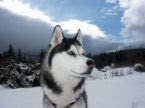
General Appearance
The Ibizan's clean-cut lines, large prick ears and light pigment give it a unique appearance. A hunting dog whose quarry is primarily rabbits, this ancient hound was bred for thousands of years with function being of prime importance. Lithe and racy, the Ibizan possesses a deerlike elegance combined with the power of a hunter. Strong, without appearing heavily muscled, the Ibizan is a hound of moderation. With the exception of the ears, he should not appear extreme or exaggerated. In the field the Ibizan is as fast as top coursing breeds and without equal in agility, high jumping and broad jumping ability. He is able to spring to great heights from a standstill.
Characteristics
The Ibizan has an elegant, deer-like look. The eyes are oblique and small, ranging in color from clear amber to caramel. The rims are the color of the nose and are fully or partially pigmented. The appearance of the eye is intelligent, alert and inquisitive. The ears are large, pointed, and natural. On alert the ear should never droop, bend, or crease. Highly mobile, the ear can point forward, sideways, or be folded backward, according to mood. On alert, the lowest point of the base is at level of the eye. On frontal examination, the height of the ear is approximately 2? times that of the widest point of the base.
Owning
Ibizan Hounds are very neat dogs who clean themselves much like cats. Ibizan Hounds require a great deal of exercise and should only be allowed off leash in a fenced in area. They are very agile dogs, able to jump great heights from a standstill. It is recommended that Ibizan Hound owners have fences at least 6' in height. The Ibizan Hound is even-tempered, affectionate, loyal, and friendly, and makes an excellent family pet.
Temperament
The Ibizan Hound is even-tempered, affectionate and loyal. Extremely versatile and trainable, he makes an excellent family pet, and is well suited to the breed ring, obedience, tracking and lure-coursing. He exhibits a keen, natural hunting instinct with much determination and stamina in the field
Did You Know
Phoenician sailors are said to have brought these dogs to the island of Ibiza in the eighth century. Hannibal, himself an Ibizan, took some of these dogs with him on his famous trip across the Alps. Ibizan Hound history is traceable back to approximately 3400 B.C. Ibizan Hound breeding stock was first imported to the U.S. by Colonel and Mrs. Consuelo Seoane. Their first two hounds, Hannibal and Tanit, produced a litter of eight puppies on September 3, 1956. The Ibizan Hound Club of the United States became an AKC member club and gained specialty show status in 1992.








